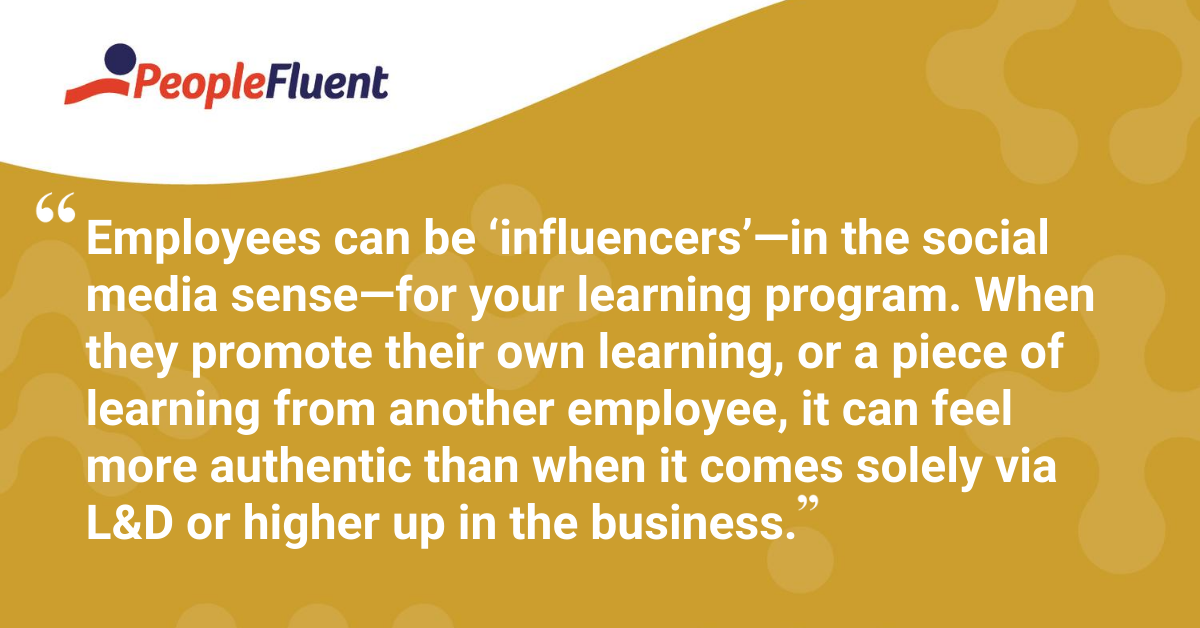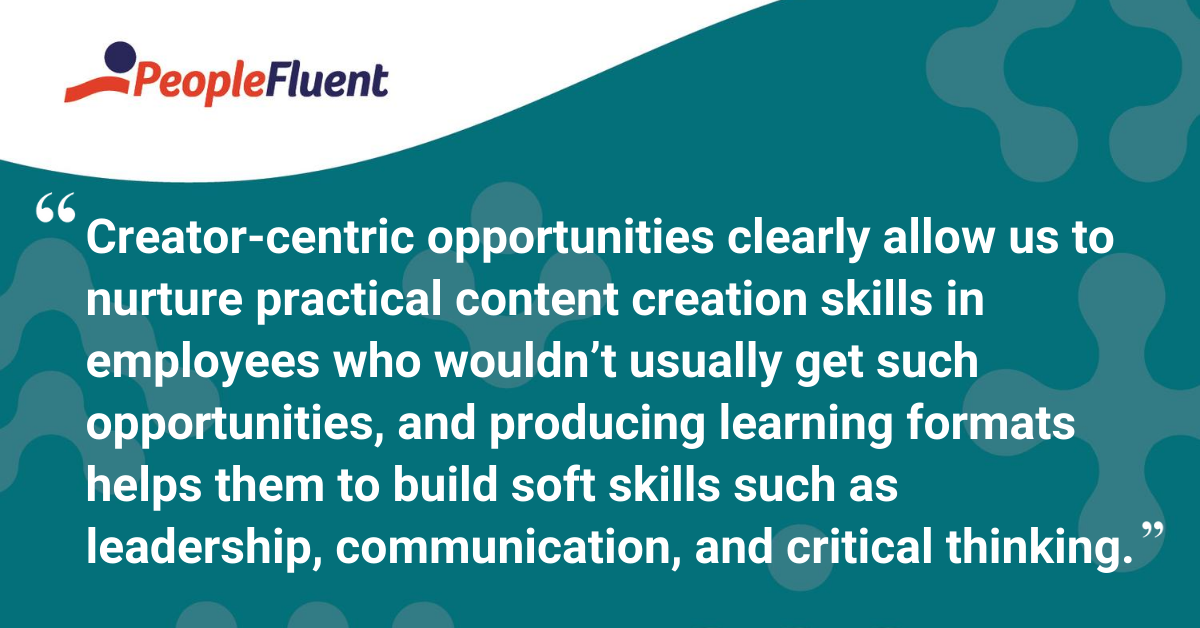Published: Aug 24, 2020Time to read: 6mins Category: Learning
5 Ways a Creator-Centric Approach Prepares L&D for a Changing Role
Extracted from the latest Instilled by PeopleFluent ebook, ‘Our Creator-Centric Future: How to Build Effective Learning Programs in a World Where Everyone Is a Creator’, we look at five ways in which you can use employee-authored learning content to stay ahead while L&D’s responsibilities are inevitably transformed.
PeopleFluent’s white paper, ‘A Human Framework for Reskilling: How 5 Seismic Forces Are Driving the Reinvention of Learning & Talent’ described five “seismic forces” that organizations are subjected to in the current market. These are:
- Increasing complexities in business operations and work.
- The constant—and constantly accelerating—pace of change.
- Unprecedented demographic shifts that are shrinking talent pools and bleeding tacit knowledge out of the organization.
- An increasing need for sustainable productivity to create a competitive advantage.
- Changing employee expectations around work and the workplace.
The response from HR and L&D will require new talent and learning strategies that inspire and engage the workforce, as well as the right learning technologies and talent management systems. Creator-centric platforms—such as learning experience platforms—have great potential to inspire and engage different demographics. Learning professionals will inevitably find their roles changing to accommodate all this change, but the platforms themselves have the power to assist the transition.
You might also like: ‘3 Ways to Support Informal Learning (Even During Lockdown)’
Facing the Future for L&D With Creator-Centric Learning

1. Complexity
As explained in ‘A Human Framework for Reskilling’, “The more individuals, governments, and organizations are connected, the more complex our systems”. In employment, this means jobs that demand broader knowledge and deeply specialized skills—factors that both demand more learning time and compress the amount of time actually available in a role in which we can learn.
Creator-centric tactics can better bring learning into the flow of work, allowing for material that fits more comfortably around other work. Employees are always teaching each other in the field. Giving them a place where they can share video footage of a teaching moment that would otherwise be lost can be very time efficient. L&D’s efforts and platform capabilities can then ensure that the next time someone needs to answer the same question, the answer is no more than two clicks away.
At PeopleFluent, we’ve seen this in action at Union Tech (UTLX)—our case study is essential reading if you would like to see this in practice. Read more about it here.
Recommended reading: ‘Hollywood Hacks: 4 Ideas for Affordable, Professional-Quality Video Learning Content’
2. Pace of Change
Technology itself is the cause of much of the change in our organizations, and we’ve recently seen how, sometimes, technological change doesn’t come with all that much warning. Adding a creator-centric platform does contribute to this sense of rapid change, so it’s important to introduce it with the right messaging. It’s also vital to demonstrate that it can be a net positive for understanding and getting the most out of all the new technology coming into the organization.
And who better to demonstrate the strengths of creator-centric platforms than your employees? Your rollout should have two targets in mind:
- Make managers the nexus of reskilling: managers hold the attention of the teams you want to reach, and a wealth of great information that’s often untapped.
- Make employees the nexus of learning influence: employees can be ‘influencers’—in the social media sense—for your learning program. When they promote their own learning, or a piece of learning from another employee, it can feel more authentic than when it comes solely via L&D or higher up in the business.
Related reading: ‘Permanent Remote Working? How COVID-19 Is Reshaping the L&D Landscape’

3. Demographic Shifts
We’ve covered the benefits of a creator-centric approach for the Gen Z and Baby Boomer members of your workforce previously: Gen Z want to join organizations that nurture their creativity and will empower them to create. There’s a risk that the last Baby Boomers will leave the workforce before we can record the knowledge they’ve accumulated.
Beyond these insights, we feel it’s worth stating that we strongly believe that everyone should get the chance to create training content, regardless of their stage of employment or enthusiasm for content creation. New hires of any age will have a reaction to onboarding that will be valuable, for instance.
4. Competitive Productivity
Back in 2015, the McKinsey Global Institute suggested that the US economy as a whole had reached only 18% of its digital potential, with lagging sectors less than 15% as digitized as their leaders. Digital technologies have always been assumed to be one way we can drive a ‘productivity recovery’—and at the least, a creator-centric approach promises to be a more efficient one.
Here’s why:
- Through AI and superior user interface design common in creator-centric platforms, we can discover the necessary information quicker.
- Frontline employees have the specialist knowledge about the methods, the products, the technologies that they work with. It’s quicker and no less effective to have them record a video about these elements, for distribution via a creator-centric platform.
- Offloading more learning creation to frontline employees leaves learning professionals more time to work on finding better ways of packaging those insights for better knowledge retention.

5. Changing Relationship to Work
The trend in business, in general, has been to take steps to consider “the whole person” in our HR and L&D decisions. Creator-centric opportunities clearly allow us to nurture practical content creation skills in employees who wouldn’t usually get such opportunities, and producing learning formats helps them to build soft skills such as leadership, communication, and critical thinking.
Furthermore, granting content creation responsibilities to an employee can contribute to overall wellbeing and helps to create a positive opinion of the organization.
You may be interested in reading: ‘5 Reasons Why the ‘Netflix of Learning’ May Be a Bad Idea’
Continue Reading
The full version of this chapter looks additionally at the current role of learning professionals and how their responsibilities are already split across a wide range of roles—with some reports suggesting that only 29% of L&D time is spent building or sourcing learning programs and content.
Discover these insights and more in the full version of our ‘Creator Centric’ ebook, as we take a look at why:
- Lockdown has simply accelerated creator-centric trends: The ebook discusses how advances in technology such as smartphone cameras and social networks have democratized content creation in our daily lives. It notes that consumer audiences prefer user-generated content (UGC)—they are 2.4 times more likely to say UGC is more authentic than branded content. Surely the same is true for learning content?
- Creator-centric trends are a solution to demographic shifts in the workforce: On the one hand, the unique expectations of a generation (Gen Z) that has largely never experienced a world without Wi-Fi, broadband, smartphones, streaming entertainment and social media. On the other, the plentiful know-how and leadership skills we are due to lose as baby boomers continue to retire.
Are you ready to embrace a creator-centric L&D function?
A truly creator-centric approach isn’t about patching knowledge leaks as and when they present themselves. It needs to be a cultural decision within your organization. Find out how!